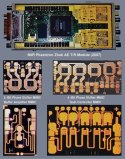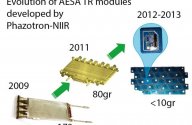Modern radars of AESA architecture require very large number of ICs for signal amplification, filtering, AC/DC conversion, digital processing. Then there's precision guided munition, cruise missiles, anti-air missiles, etc with similar requirements. I've seen Russian AESA radar designs with American made Altera/Xilinx FPGA chips and Texas Instrument chips among others. This is the sort of technology that not even China is capable of replacing at the moment, at least not on the state-of-the-art level.
What you saw --- what I posted --- was an AESA board dated around 2007. If it has Altera FPGA dated 2007, then it is something the Chinese would have exceeded long ago. FPGA is also used for prototyping purposes; it does not necessarily mean it will be the chip used on the final product. On the contrary, using FPGA not only is more expensive, but produces more heat and can be slower than hardwired mass manufactured for that purpose ASIC. If you are making prototype radars, using FPGA is fine, but once the radar goes into mass manufacture, each array can have thousands of elements, and at this point, it would make sense to go to ASIC instead.
ICs used in radars and military applications are not necessarily using the smallest nanometer available. On the contrary, trying to use the smallest process possible makes those smallest transistors more vulnerable to interference, cosmic rays and EMP. In fact, when it comes to space applications, satellites and probes, the chips used are those from old processes with the larger transistor size. It is a good idea to keep obsolete semiconductor processes to produce chips for military and space programs.
As a reminder, power ICs do not require or use the smallest nanometer processes. As power circuits, its the opposite. This includes the all important amplifiers.
I saw one of RT documentaries that are showing a special laboratory making modules for radars, and it was a careful hand made process using generics.

You can see the Altera FPGA on the 2007 board, but the phase shifter and the amplifier are all custom made.
In later years, the design has radically changed.

